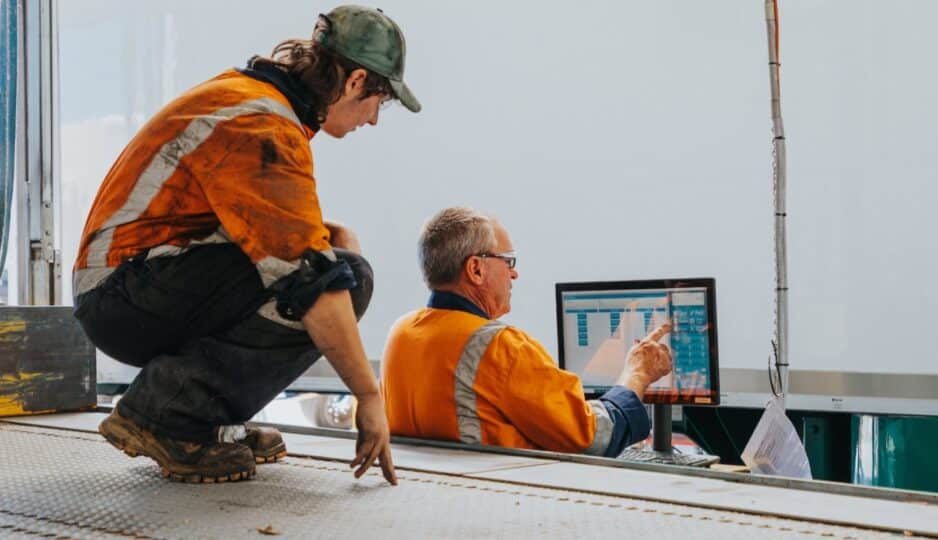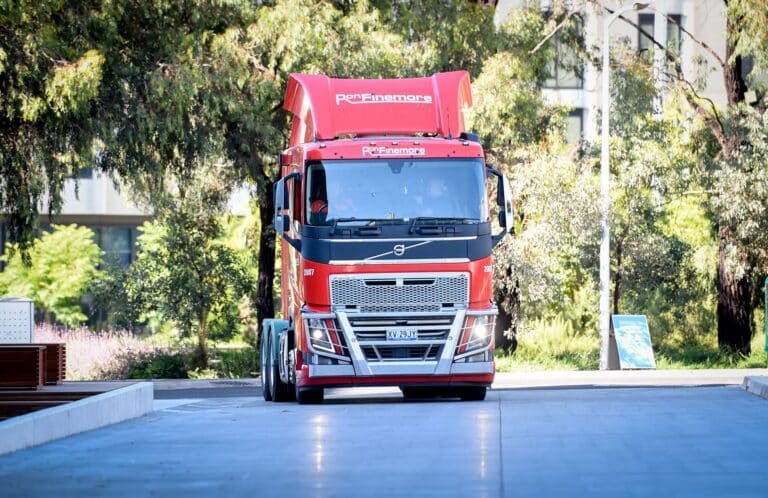Leading-edge transport operators are deploying advanced truck telematics powered by artificial intelligence to gain a competitive advantage from the reams of data now being collected across multiple technology platforms
Autonomous on-road trucks may still be a pipe dream, but some leading Australian transporters are already employing artificial intelligence (AI) powered robots to not only automate operations but predict future problems, from mechanical failures to fatigue incidents.
AI and machine learning are set to be central themes across technology exhibitions at the 2023 Brisbane Truck Show, with key vendors ranging from telematics providers Teletrac Navman, Geotab and Orbcomm, to driver safety monitoring systems suppliers Driverisk and Mobileye, expected to showcase their cutting-edge AI-powered solutions at the event.
Teletrac Navman’s Chief Product Officer Andrew Rossington says these new-generation technologies reflect a fundamental shift under way by both vendors and customers, from capturing historical data to “real time, predictive” data.
The company’s most recent Telematics Benchmark Report found telematics use was largely limited to tracking vehicles and equipment.
Almost 80 per cent of operators surveyed were using their telematics for vehicle and equipment tracking, 68 per cent for speed, 53 per cent for hours of service/driver hours, and 51 per cent for distance driven.
Fewer than half were employing the technology to monitor driver performance (42 per cent), proof of service/jobs completed (37 per cent), and maintenance (37 per cent).

Three years on, however, Rossington says there has been significant growth in the adoption of telematics by small-to-mid-sized operators, which had previously been lagging larger transporters.
He says this has principally been driven by increased compliance requirements and the opening of access to higher-productivity truck routes.
At the same time, the technology has become more widely available and more affordable.
With this, operators – especially medium to large transporters – are now focusing on “taking compliance from a cost to an opportunity”.
“Before 2015-16 (the technology) was all about where’s my vehicle, what has it been doing, where has it been,” he says.
“Operators are saying how can I take this data (collected by EWDs) and use it to help improve driver performance. I’ve got reams of data, how can I use it to make my operation better through better journey planning, better fleet usage.
“They are trying (to use the data) to make the driver, the fleet, the delivery more efficient and more safe.
“I strongly believe that what operators are going to be looking for is getting leverage, getting advantage out of their telematics data.”

That’s where artificial intelligence and machine learning come in.
For example, Rossington says Teletrac Navman’s Smart Dashcam collects and records data on incidents and accidents.
“What we then need to do is put all this data into the context of the whole trip so that we are able to predict if (an incident) is going to happen again,” he says.
“We’re trying to answer questions such as what’s the best vehicle for the task, for the route; who’s the best driver with available hours, work history etc to do the task.
“It’s early days, the first thing we’re doing is building out the data so we can provide a level of predictability. And the first services we are providing are various downloads and insights.
“For example, if you are experiencing an extended wait time on a site we’re leveraging the data to ask when and where and is there a pattern. The next phase is how we provide the answers upfront.”
Robots hit the road
At the leading edge of this brave new world is mid-sized family-owned operator Ron Finemore Transport.
Established by industry icon Ron Finemore in 2004 following the acquisition of Wodonga-based company Lewington’s Transport, the carrier boasts a fleet of around 300 trucks across three major operating divisions: food, produce and manufactured goods, and bulk liquids.

With a strong safety culture, RFT’s technology journey began back in the early 2000’s, however, it really took off in 2013 when it adopted the Orbcomm (Bluetree) telematics solution.
RFT General Manager Business Development, Technology and Innovation Darren Wood says the solution allowed it to track vehicles as well as providing data that enabled it to score how well drivers were performing against set parameters, including speed, idling, harsh braking, and over revving.
Around the same time, RFT came across Seeing Machines’ driver monitoring technology for the first time. At that time the system only included an inward-facing camera focused on monitoring the driver.
“We said we also needed to see what was going on in front of the driver and we got them to put forward-facing cameras into the Guardian product. We then adopted it 100 per cent in our fleet,” he says.
RFT’s Driver Safety System (DSS) comprises an infrared driver-facing camera (DFC), and a colour forward-facing real image camera synced with the DFC, to monitor a driver’s eyes and head position to identify potential fatigue and distraction events, specifically wheel speed >40kph, eyes closed >2 seconds (fatigue event); and wheel speed >40kph, eyes off centre >4 seconds (distraction event).
This real-time device alerts the driver by a seat vibration and alarm in the case of a fatigue event and further sends an alert to RFT’s operations team — in turn, allowing them to make immediate contact with the driver to see if they are okay and suggest they take a break if necessary.
“It’s a wonderful product. For example, if you get a fatigue event we’re contacting the driver immediately. If they are fatigued, we recommend that they have a 15-minute break,” Wood says.
The data allows RFT to have “informed conversations” with drivers about unsafe driving behaviours and to make required improvements.

Wood says that in 2015 RFT made a “strategic decision” that its core operating platform was “not fit for purpose for the long term”.
After searching for new solutions domestically and internationally, in 2016 the company invested in a suite of Trimble products, including its Truckmate dispatch, operations and accounting system. The system went live in 2017.
“At that point in time we had a vision of trying to integrate the TMS (transport management system) with our in-cab (telematics) system. We realised we knew a lot of this information from our telematics system; we knew what the driver was doing, we knew when the driver had arrived,” he points out.
“So, we made a decision that what we really needed to know was what we didn’t know. We needed to add more value (from our technology investments), so we started on our next phase which was how do we get all these systems to talk to each other by sharing the data across platforms.”
Previously, providing accurate status updates for each load required the company to manually re-key the position and activity data into its TMS.
To eliminate this manual process, RFT selected Kofax RPA (Robotic Process Automation) — an AI-powered robotic process automation platform.
Today, a software robot imports the real-time location of each truck into a central data warehouse, and then matches the record to the correct route in the TMS. When a truck enters or leaves a geofenced location such as a fuel station, delivery point or freight terminal, the robot automatically applies the appropriate delivery status update in the TMS.
“From the very start, we knew that we wanted a fully automated solution. Thanks to Kofax RPA, we’ve slashed the need for manual work down to just half an FTE,” he says.

RFT has since deployed around 12 software robots across the business to optimise other process areas and plans to deploy more in the future.
“Now that we’re up and running with Kofax RPA, we have a world of automation possibilities,” Wood says.
“For example, a member of the team used to spend around 20 minutes each day collecting the latest fuel prices from across our delivery network and then inputting them into a spreadsheet. This data plays a key role in planning the optimal fuel stops for our drivers, and today we use a software robot to complete the process in just three minutes — a time-saving of more than 10 hours each month.”
RFT is also using Kofax RPA to integrate its operations more tightly with large clients. The company recently created a robot to automate its order acceptance process for Woolworths.
Previously, two employees spent around six hours per day capturing orders, building the loads in the TMS, and coordinating time slots for collections and deliveries.
By using a software robot to automate key stages of the workflow, RFT has cut the order acceptance process down to just one hour of human effort per day, while boosting its data-quality score from 70 per cent to over 90 per cent.
“We see that the logistics industry is only going to become more data-driven in the years ahead. Thanks to our work with Kofax, we’re in a strong position to build the next generation of digital services and become trusted partners to more businesses across Australia,” he says.
Wood adds that integrating data from the TMS, telematics and in-cab camera systems also enables the company to get a clearer view of driver performance, including areas in need of improvement.

RFT delivers training and education campaigns with all drivers via Yarno, a digital remote learning platform.
“Yarno allows us to deliver burst campaigns to our drivers that are designed to reinforce key learnings and provide us with insights on any gaps that require greater attention,” RFT Managing Director Mark Parry wrote recently.
The next stage in RFT’s journey is to have its trucks fitted with tablets that will have many features to aid the driver including notifications of upcoming hazards as they occur, in real-time, giving them control and confidence to shield them and the community from potential hazards.
Wood adds that RFT now has access to data at a very detailed level that enables it to predict future events, such as mechanical failure.
“We’re now able to tell OEMs that they’ve got an issue with a part even before they know it,” he says, adding RFT has a “new project in play that will give us lead indicators that we know may result in an incident. It’s an exciting opportunity to deliver more information for our business in our ongoing quest for safety and reliability.”





